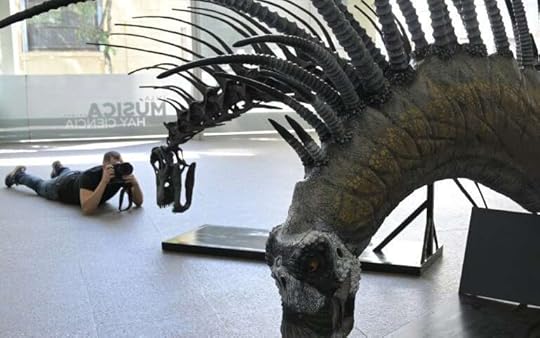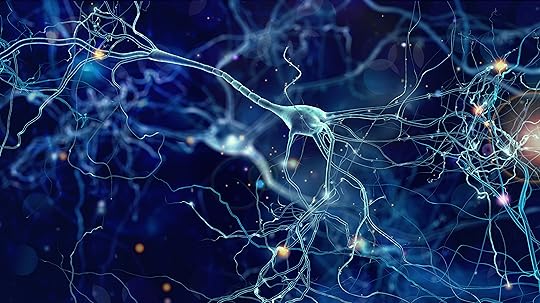Michael J. Behe's Blog, page 523
February 17, 2019
Be kind to ET. He is some people’s deity.

We are told that “We need to tread lightly if we encounter alien ecosystems”:
Well, failing to do that is one sin we can safely say we haven’t committed; we have never encountered an alien ecosystem.
At the same time, it is important to keep in mind that nothing done by humans really matters in the big scheme of the universe. Humans have access to an extremely limited fraction of the cosmic reservoirs of energy and mass, and to potential places for life; there are 10^20 habitable Earth-like planets in the observable volume of the universe, so the human imprint on the cosmic stage is destined to remain negligible. Perhaps we should limit our cosmic ambitions in light of this perspective.Abraham Loeb, “Be Kind to Extraterrestrials” at Scientific America
Loeb? Name rings a bell. Oh yes, he identified that object that entered the solar system, Oumuamua, as an “extraterrestrial light sail.”
It’s interesting that Scientific American makes space for this. It’s fine, really, as long as we acknowledge that it is a religion.
See also: Tales of an Invented God The most important characteristic of an AI cult is that its gods (Godbots?) will be created by the AI developers and not the other way around. They will mesh with ET, an eternal cyborg who is always Out There.
and
Astronomers: Solar System Object In Transit, Oumuamua, Might Be A “extraterrestrial light sail.”” target=”another”>“Light Sail Of Extra-Terrestrial Origin”
Follow UD News at Twitter!
Copyright © 2019 Uncommon Descent . This Feed is for personal non-commercial use only. If you are not reading this material in your news aggregator, the site you are looking at is guilty of copyright infringement UNLESS EXPLICIT PERMISSION OTHERWISE HAS BEEN GIVEN. Please contact legal@uncommondescent.com so we can take legal action immediately.Plugin by Taragana
Gaming culture’s assumption about artificial and human intelligence

A gamer looks at Detroit: Becoming Human where, of course, you can choose what happens:
Detroit 2038. The city has transcended its current economic despair, emerging as the epicenter of an android revolution. Cyberlife, headquartered there, is the first company to engineer and produce fully autonomous, general purpose AI androids for consumers. They are bought and used like laptops. Go to a Cyberlife store, purchase your new maid or nanny, and go home with it.
The story centers around three of these androids; Markus, Kara, and Connor. In the first chapter, Markus lives with Carl Manfred, an elderly painter. Carl is kind and loving; he teaches him that not all humans are evil. But Carl dies of a heart attack in his studio and his son Leo (who had arrived to steal his father’s paintings for money) blames Markus. Two police officers promptly arrive and shoot Markus, shutting him down.
Markus wakes up at the bottom of a trash pit filled with the scraps and leftovers of countless androids. Somewhat like a phoenix rising from the ashes, he slowly repairs himself and makes his ascent to the top. He emerges changed; he is no longer just an android. For the rest of the story, he goes on to free countless other androids from their programming and give them free will (I’ll get to the blatant religious symbolism later).Adam Nieri, “A Closer Look at Detroit: Become Human, Part 1” at Mind Matters
Hey, if there’s another huge snowstorm out there…
See also: Does brain stimulation research challenge free will? (Michael Egnor)
Follow UD News at Twitter!
Copyright © 2019 Uncommon Descent . This Feed is for personal non-commercial use only. If you are not reading this material in your news aggregator, the site you are looking at is guilty of copyright infringement UNLESS EXPLICIT PERMISSION OTHERWISE HAS BEEN GIVEN. Please contact legal@uncommondescent.com so we can take legal action immediately.
Plugin by Taragana
February 16, 2019
Animals that Shouldn’t Exist According to Intelligent Design
I thought that this video was amusing. This is a public lecture given by a scientist on the subject of Intelligent Design. This is what passes for public discourse today.
Copyright © 2019 Uncommon Descent . This Feed is for personal non-commercial use only. If you are not reading this material in your news aggregator, the site you are looking at is guilty of copyright infringement UNLESS EXPLICIT PERMISSION OTHERWISE HAS BEEN GIVEN. Please contact legal@uncommondescent.com so we can take legal action immediately.
Plugin by Taragana
Finally, the Details of How Proteins Evolve
How did proteins evolve? It is a difficult question because, setting aside many other problems, the very starting point—the protein-coding gene—is highly complex. A large number of random mutations would seem to be required before you have a functional protein that helps the organism. Too often such problems are solved with vague accounts of “adaptations” and “selection pressure” doing the job. But this week researchers at the University of Illinois announced ground-breaking research that provides a step-by-step, detailed, description of the evolution of a new protein-coding gene and associated regulatory DNA sequences. The protein in question is a so-called “antifreeze” protein that keeps the blood of Arctic codfish from freezing, and the new research provides the specific sequence of mutations, leading to the new gene. It would be difficult to underestimate the importance of this research. It finally provides scientific details answering the age-old question of how nature’s massive complexity could have arisen. As the paper triumphantly declares, “Here, we report clear evidence and a detailed molecular mechanism for the de novo formation of the northern gadid (codfish) antifreeze glycoprotein (AFGP) gene from a minimal noncoding sequence.” Or as lead researcher, professor Christina Cheng, explained, “This paper explains how the antifreeze protein in the northern codfish evolved.” This is a monumental finding. Having the scientific details, down to the level of specific mutations, of how a new protein-coding gene evolved—not from a related gene but from non-coding DNA—is something evolutionists could only dream of only a few short years ago. There’s only one problem: it is all junk science. Read more
Copyright © 2019 Uncommon Descent . This Feed is for personal non-commercial use only. If you are not reading this material in your news aggregator, the site you are looking at is guilty of copyright infringement UNLESS EXPLICIT PERMISSION OTHERWISE HAS BEEN GIVEN. Please contact legal@uncommondescent.com so we can take legal action immediately.
Plugin by Taragana
Answer questions about ID and maybe win a prize

Access Research Network is offering a prize ($50 VISA gift card) for the best response to this question: What do you say to someone when they claim that Intelligent Design is merely an appeal to a god-of-the-gaps?”
Send your response to arn@arn.org
Here’s the January question: How would you would respond to someone who claims that they believe in evolution rather than God? along with the answers and the winner, to give you some idea what they are looking for.
No one’s name is published without their permission.
FYI, here’s the winning answer:
Response 3: What do you mean by evolution?
First I would ask whether they mean chemical or biological evolution. Then I would ask them what they mean by evolution… I would say : “My hair colour has changed over time, thus it has evolved. Is that what you mean?” Then, assuming they mean large scale macroevolution, I would ask them about information, and do they understand that DNA is like computer code. Finally, I would ask them whether they believe as they do because of their upbringing and education, or whether they are personally convinced after looking at both sides.
Follow UD News at Twitter!
Copyright © 2019 Uncommon Descent . This Feed is for personal non-commercial use only. If you are not reading this material in your news aggregator, the site you are looking at is guilty of copyright infringement UNLESS EXPLICIT PERMISSION OTHERWISE HAS BEEN GIVEN. Please contact legal@uncommondescent.com so we can take legal action immediately.
Plugin by Taragana
Newly discovered dinosaur had very long spikes, purpose disputed

Bajadasaurus pronuspinax/Cultural Science Center, Buenos Aires
A bizarre dinosaur from about 140 million years ago found in Argentine Patagonia had an amazing row of curved spikes running along its spine:
The discovery of the new species of dicraeosauridae, christened Bajadasaurus pronuspinax, was revealed in Scientific Reports.
A reproduction of its spiny neck was exhibited in the Cultural Science Center in Buenos Aires.
“We believe that the long and sharp spines—very long and thin—on the neck and back of Bajadasaurus and Amargasaurus cazaui (another dicraeosauridae) must have been to deter possible predators,” said Pablo Gallina, an assistant researcher at the state council of scientific and technical investigations (CONICET) and Maimonides University.
“We think that had they been just bare bone structures or covered only by skin, they could have been easily broken or fractured with a blow or when being attacked by other animals,” he added.
“These spines must have been covered by a keratin sheath similar to what happens in the horns of many mammals.”
Bajadasaurus was a quadruped and part of the wider Sauropod family that lived from the late Triassic period (around 230 million years ago) until the end of the late Cretaceous (70 million years ago). “Dinosaur that defended itself with spiny backbone found in Patagonia” at Phys.org
It’s not clear what the spikes did:
Possibilities include heat regulation (an issue for large-bodied sauropods), sexual display (horns to make dinos horny), a fat reservoir (the fat stores would be located between the spikes, and similar to a camel’s humps), and defense against predators. The authors of the new study, led by Pablo A. Gallina from Universidad Maimónides, favor the idea that the spines served as “passive defense structures.”George Dvorsky, “Newly Discovered Spiked Dinosaurs From South America Look Like Creatures From ‘No Man’s Sky’” at Gizmodo
Other authors think the spines were only for display. Expect journal articles. Fascinating find.
See also: The asteroid strike was only one factor in dinosaur extinction
Study of baby diplodocus skull prompts new theories of dinosaur behavior
and
“Nastiest feud in Science” erupts over dinosaur extinction
Follow UD News at Twitter!
Copyright © 2019 Uncommon Descent . This Feed is for personal non-commercial use only. If you are not reading this material in your news aggregator, the site you are looking at is guilty of copyright infringement UNLESS EXPLICIT PERMISSION OTHERWISE HAS BEEN GIVEN. Please contact legal@uncommondescent.com so we can take legal action immediately.Plugin by Taragana
FIRE’s Ten Worst Colleges for Free Speech
Grad season looms, with gowns, gear, and gifts. If you like living in a free society and following evidence rather than living by rules about not offending toxic snowflakes, here are Foundation for Individual Rights in Education’s 10 colleges to most avoid before you take on loans you can never repay. For example:
Rensselaer Polytechnic Institute (Troy, N.Y.) You can’t “eminent domain” away students’ free speech rights. But this college tried. Eastern New York’s Rensselaer Polytechnic Institute was an easy choice for our 2018 list of worst colleges for free speech. When we learned that students passing out buttons and flyers critical of RPI’s administration were told by campus security officers to “vacate” the sidewalk because of “eminent domain,” we knew the school was likely to be on this year’s list, too. And here it is.
To be clear, “eminent domain” — the power of the government to take private land for public use — is a legal concept with no bearing on the situation whatsoever. Rather than chalk it all up to a misunderstanding and pledge to revisit its policies, RPI’s administration cited a policy that it claimed requires students to get “prior authorization” before they “distribute materials on campus.” (It doesn’t.) RPI has a long history of relying on poorly-written policies to censor speech whenever controversy arises. “10 Worst Colleges for Free Speech: 2019” at FIRE
This is your academic home if you are an authoritarian bureaucrat in training. Or maybe your subject area is, for example, sexual assault among dogs. If so, academia is all yours.
With any luck, you will be shouting down empty halls.
Has any university you give money to signed the Chicago Statement yet?
See also: Social sciences: Putting a respectable face on persecuting the hoaxers
Follow UD News at Twitter!
Copyright © 2019 Uncommon Descent . This Feed is for personal non-commercial use only. If you are not reading this material in your news aggregator, the site you are looking at is guilty of copyright infringement UNLESS EXPLICIT PERMISSION OTHERWISE HAS BEEN GIVEN. Please contact legal@uncommondescent.com so we can take legal action immediately.
Plugin by Taragana
“Humans still marry Neanderthals?” This is what some people call science
In case you wondered:
But sometimes women marry up (the lady Neandertal bedding H. sapiens), and sometimes women marry down (the “wise one” female falling in love with the Neandertal). Psychologists have terms for this behavior of selecting mates outside one’s own group: “hypergamy” and “hypogamy,” for marrying up or down, respectively, but as with most technical jargon, the scholarly vocab contributes little. The question is, why do women do it?
We needn’t dwell on marrying up—gold digging everyone understands—but marrying down is another matter. What do women see in the dumb but lovable Neandertals they pick today and in the prehistoric mating game 100,000 years ago? This question is especially important now, because women are making the Neandertal choice more now than ever, and the trends are likely to continue into the future. R. Douglas Fields, “Humans Are Still Mating with Neandertals“at Scientific American
May we now blame Neanderthals for our own wrong choices? Wow. 
February 15, 2019
New Pew Survey creates a huge middle on evolution
After 15 years, the polling firm changed the way the question was asked: “Half of the respondents were asked about evolution in a two-step process much like the one described above. The other half of respondents were asked a single question about their views on evolution and given three response options” The graphic is pretty self-explanatory.

The pollster wanted to avoid forcing people to choose between science and religion:
The results of the new experiment indicate that there are some people who do believe that humans have evolved over time, but who, for whatever reason, did not say so in our traditional method of asking about the topic. Perhaps without the opportunity to immediately connect evolution to God, some religious respondents may be concerned that expressing belief in evolution places them uncomfortably on the secular side of a cultural divide. “The Evolution of Pew Research Center’s Survey Questions About the Origins and Development of Life on Earth” at Pew Research Center
Darwinian evolutionary biologist Jerry Coyne (hat tip!) doesn’t like what happened to Naturalism (nature is all there is), often called “materialism” in the numbers:
As you see, if you give people three alternatives at once, pure creationism falls from 31% to 18%, theistic (guided) evolution rises from 27% to 48%, and, surprisingly, unguided, natural evolution falls from 40% to 33%. Somehow Pew sees this as good news, though I don’t: if you lump those who see God directing evolution (a watered down form of creationism, like Behe’s) with de novo creationists, the total of non-“naturalists” under the new protocol is 66%, while it was 58% before. And there are 7% fewer people who accept naturalistic evolution under the new protocol.Jerry Coyne, “Americans’ acceptance of evolution: does it depend on how you ask them?” at Why Evolution Is True
Actually, it’s not surprising at all. Pure naturalist atheists are not that common once you get off campus and a safe distance from the raging Woke. Most people would rather you think they were creationists (provided you don’t push it too far), which likely accounts for the drop in the second set, when a clear alternative for theists is provided. Some of us think this change in questions is long overdue.
Other polls will ask different questions (they have to) and get different answers.
See also: Are polls scientific?
Follow UD News at Twitter!
Copyright © 2019 Uncommon Descent . This Feed is for personal non-commercial use only. If you are not reading this material in your news aggregator, the site you are looking at is guilty of copyright infringement UNLESS EXPLICIT PERMISSION OTHERWISE HAS BEEN GIVEN. Please contact legal@uncommondescent.com so we can take legal action immediately.Plugin by Taragana
Even our neurons’ axons are like smart PCs

If you want to see your brain in electronic terms, you should picture it as the biggest network imaginable. It’s widely accepted that each neuron in our bodies is complex enough to be something like a little computer. Neurons are considered “pretty weird” on that account:
“Unlike their blobby brethren, neurons have distinct regions. There’s the cell body, home to the nucleus. Then come the axons and dendrites, the signal-carrying and signal-receiving parts of the neuron that send long, spindly arms to form connections, called synapses, with other neurons. “
Harvard Medical School, “Once seen as nerve cells’ foot soldier, the axon emerges as decision-maker” at ScienceDaily
But the system turns out to be “far more complex than once thought” because, contrary to expectations, far-flung regions (thousands of cell body widths from their nucleus) can even make independent decisions: More.
See also: Could DNA be hacked, like software? It’s already been done. As a language, DNA can carry malicious messages
and
The brain exceeds the most powerful computers in efficiency. Eric Holloway: Human thinking takes vastly less computational effort to arrive at the same conclusions
Follow UD News at Twitter!
Hat tip: Philip Cunningham
Copyright © 2019 Uncommon Descent . This Feed is for personal non-commercial use only. If you are not reading this material in your news aggregator, the site you are looking at is guilty of copyright infringement UNLESS EXPLICIT PERMISSION OTHERWISE HAS BEEN GIVEN. Please contact legal@uncommondescent.com so we can take legal action immediately.
Plugin by Taragana
Michael J. Behe's Blog
- Michael J. Behe's profile
- 219 followers



